An Interview with Open Works’ Member Manager April Danielle Lewis
by Cara Ober
Have you ever wanted to learn how to sew? Or 3D print? Or laser cut wood? Or carve out a small space to think, create, and rub elbows with other creative makers?
After over a year of renovations and an $11.5 million dollar investment, Open Works is poised to open its doors with educational programming, memberships, and studio spaces. The 34,000 square foot makerspace is the sixth largest in the country, and will offer “advanced tools and technologies” for the general pubic through memberships, month-to-month rental workspaces, classes, and professional “workforce training opportunities in partnership with other regional organizations.” Open Works’ facilities and programming is designed for adults, children, and families; they just announced the addition of an on-site coffee roastery and a small café, Greenmount Coffee Lab, run by local cooperative Red Emma’s on the premises.
As the space prepares for a public grand opening festival on Saturday, September 24, Open Works’ Member Manager April Danielle Lewis set a few precious minutes aside to talk to BmoreArt about Baltimore’s newest makerspace.
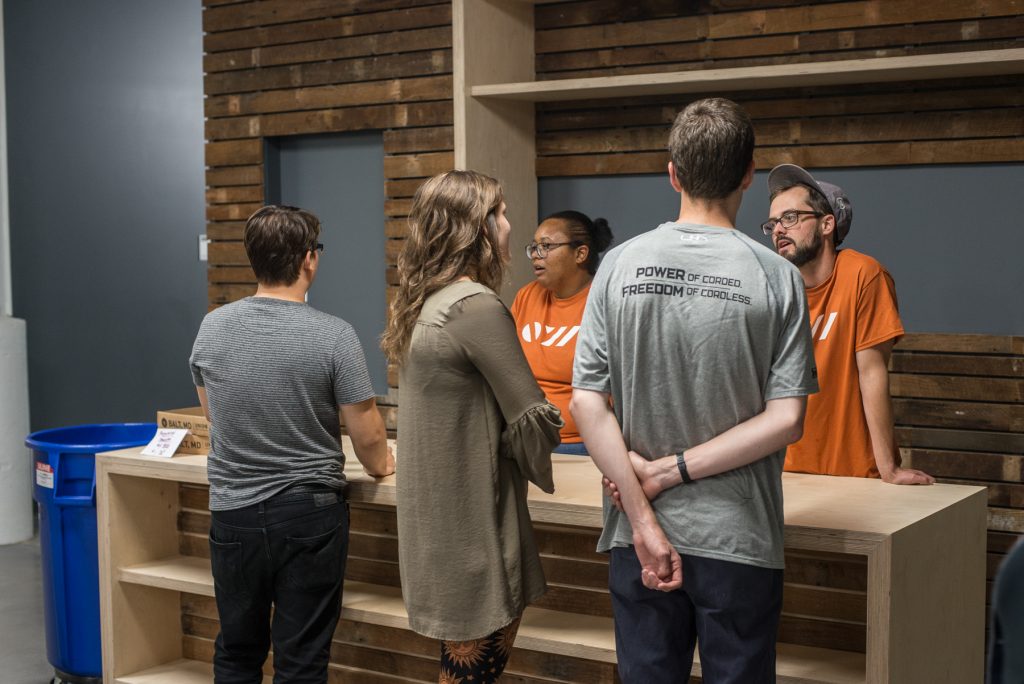 April Danielle Lewis and Will Holman talk to visitors at Open Works
April Danielle Lewis and Will Holman talk to visitors at Open Works
What exactly will you be doing at Open Works?
My official job title is Membership Manager. I am responsible for getting people signed up, developing non-educational programming and most importantly, ensuring that we have an inclusive community of makers who feel comfortable collaborating, sharing skills and knowledge.
What made you want to become part of the OW team??
When I found out about Open Works, I knew that I wanted to be a part of what was going to be happening here. With its physical location situated at the heart of Greenmount West on a major gateway to a diverse range of potential members, I wanted to be a part of creating a community of makers that could potentially be a resource for so many people.
What was your background before accepting this position?
Last year I joined the Station North Tool Library and became a tool librarian. My involvement there really made me realize how transformative the access to tools can be for everyone. From witnessing people grow their businesses, rehab their homes, become passionate about a new hobby, commit to lifelong learning, to develop a community that is inclusive and supportive, I was able to recognize, first-hand, the big role that a makerspace has within the creative community.
I am also a performance artist, mother, and chronic volunteer/ organizer. I have spent the ten years I’ve lived in Baltimore making art, raising a now teenaged child, and being engaged in the community in many different ways. I worked with a group of parents to create a non-profit community organization to support our kids’ school called Hands on Patterson Park Public (HOPPP). Also, I am an organizing member of the Baltimore Women’s Maker Collective, and for prior coming to Open Works, I was a program coordinator and adjunct professor at CCBC.
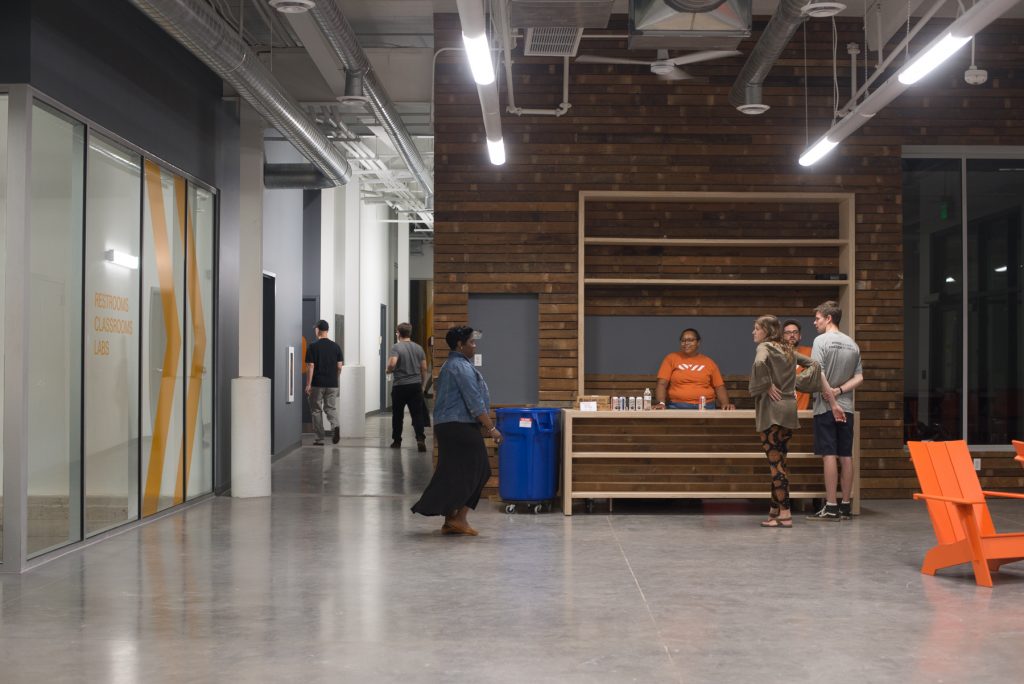
What exactly IS Open Works? Can you tell readers who it is for and how people can participate?
Open Works is a place where people have access to tools and technology, the skills to use them, and a community of people to share their skills and knowledge with.
What are the different options for those who want to take a class?
There is pretty much an option for everyone. We have after-school programming and multi-generational or family programming on the weekends. We offer safety classes to certify people to use our workshops and safely use the tools, classes to build skills, classes to learn how to make a thing, and a host of free and low-cost workshops for professional development and skill enhancement.
What are the different labs or media options available?
We have a total of seven workshops. On our top floor, we have all of our “clean fabrication” studios; a 3D printing lab with a botfarm of 8 Ultimaker 2 3D printers; a digital media lab with 6 iMacs loaded with the Adobe Creative Suite, a large inkjet printer and a blueprint/plotter printer and a light box for product photography; an electronics studio with everything needed for building circuitry, soldering/ desoldering and a large format vinyl cutter; a textile studio with 8 industrial Juki sewing machines, a serger, a CNC embroidery machine, large fabric cutting tables, dress forms, and the best natural light in East Baltimore. We also have two classrooms and a second computer lab. Our computer lab has 16 PCs loaded with 3D modeling software and is open to all members.
On the lower level we have what we like to refer to as our “dirty fabrication shops,” which consist of our woodshop, digital fabrication lab, and metal shop. The woodshop has all the traditional woodworking tools: two sawstop table saws with outfeed tables, a mitre saw, two bandsaws, a planer, a jointer, a router table, a drillpress, and a variety of sanders. There are also a variety of hand tools and clamps as well. Our digital fabrication lab has 3 laser cutters and 3 CNC routers (which can each take a 4’x8′ sheet of plywood. Our metal shop has everything needed for processing sheets and bars, mig and tig welding, a lathe, and a CNC plasma cutter.
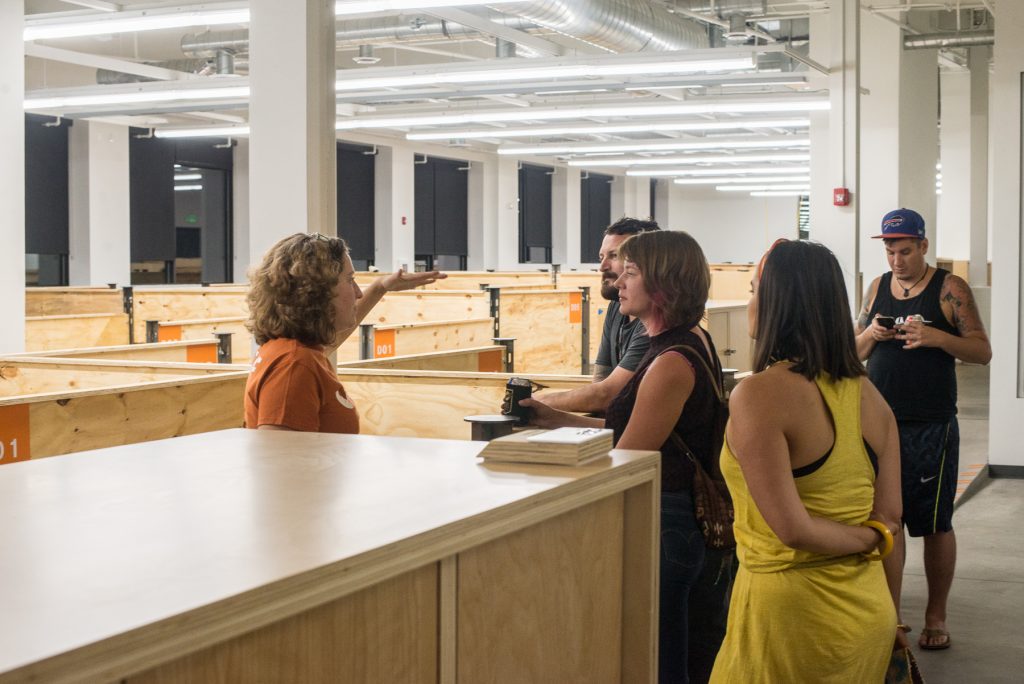
What’s the deal with micro studios? How does it work?
We have the capacity for 140 micro-studios. They are 6.5′ x 7′ cubicles in a secured area for people who want to put down roots here. We have 70 micro-studios on our top floor and there are 70 yet to be constructed downstairs. All have half walls and are modular.
You can buy two or more if you require more space and remove the walls in between for a larger workspace. Each micro-studio has its own physical address, so you can send and receive mail from here; you can use the micro-studio address as your business address (which triggers tax incentives for individual makers who produce and sell work within an arts district).
There are no contracts locking anyone in to a set amount of time. Everything is billed monthly, but you have to be a member in order to rent a microstudio.
We have 4 basic ways to be a member; you can purchase a day pass which gives you all access to all the workshops for $25 a day, our monthly maker membership plan which costs $70 a month and gives you access to our top floor of “clean fabrication workshops”, our builder membership which gives you access to our downstairs “dirty fabrication” shops for $90 a month, and our pro membership which gives you access to both floors for $125 a month.
Micro-studio rental adds and additional $125 a month to each of those plans, so $195 a month for a resident maker membership, $215 for a resident builder membership, and $250 for our all-access resident pro maker membership, so there is a plan to fit everyone’s needs.
All of our micro-studios have these low walls. You can see your neighbor and hopefully people will be working on cool things and look over and see someone else doing something they’ve always wanted to do or something they haven’t done in a while and maybe that will inspire someone to try something different or collaborate or share knowledge or ask questions.
It’s not a place where you wall yourself in to your studio and make things in a vacuum. We have a lot of top of the line equipment in this facility, but none of it is more valuable than the community.
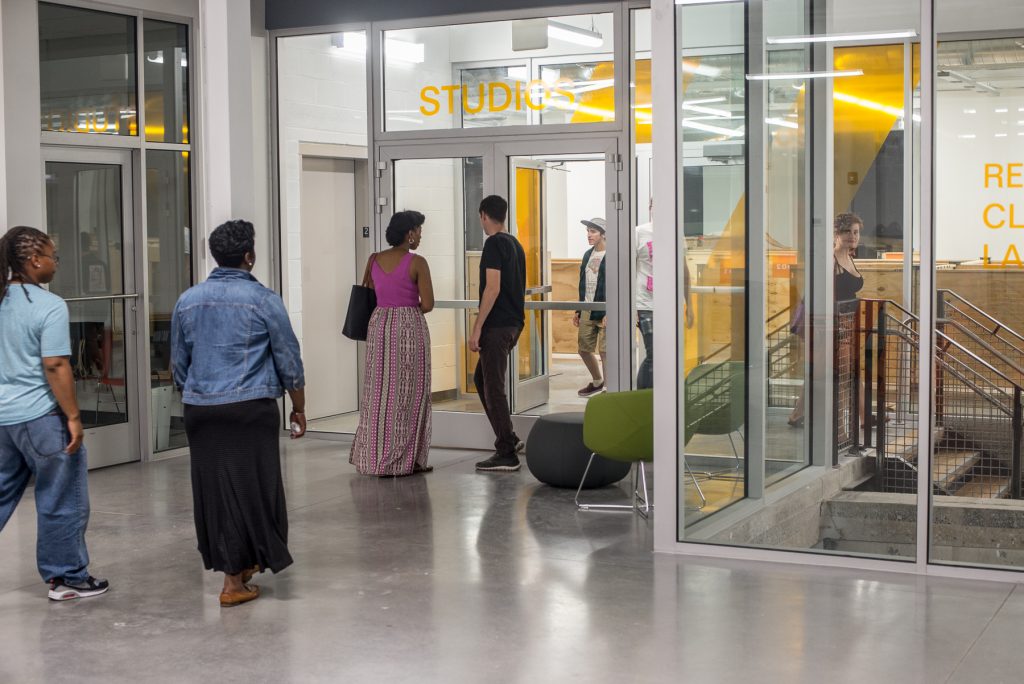
The building looks amazing, like every detail was thoughtfully considered. What’s the coolest thing, in your opinion, about the physical building space?
There are a few things about the building that are my faves, but I’d have to say that the windows are my all-time favorite.
I love the light on the west end of the building. The lighting in the textile studio is magical. The view from the windows on the bottom floor from the digital fabrication lab, if you stand near the door and look out the windows in your foreground, you see all of this newness and technology and just outside the window on the building’s Southside are the Amtrak train lines with century old beams and rail lines that go under a super old bridge and if you look up to the street above the bridge you see the brand new Lillian Jones Apartments in Johnston Square, so there is this layering of new and old and new all in one view and it’s very poetic and beautiful.
The windows on the east side on Greenmount Avenue come to life after schools let out and there are some of the most adorable tiny tots with huge backpacks and heads full of colorful barrettes and bows and balls, and moms and dads pushing strollers, and people pressing their face to the glass to see what’s going on in here all passing by in an almost constant stream. And that reminds me that we are part of this neighborhood too and the work that we do here should be open and transparent.
How do you think Open Works will impact Baltimore’s cultural landscape in the future?
Each member of the Open Works staff has been working hard to make sure that this makerspace is an inclusive resource for everyone. I think that, from a cultural perspective, there are not many places in the city that are truly intersectional. If we are successful in our efforts, it could have a huge impact on the work produced here and where we see that work in the world.
My main goal, which is both long term and short term, is to make sure that this space feels welcoming and our community members inside and outside of these doors can build relationships and make connections, and that we can all learn from one another.
Thank you and congratulations on this ambitious project!
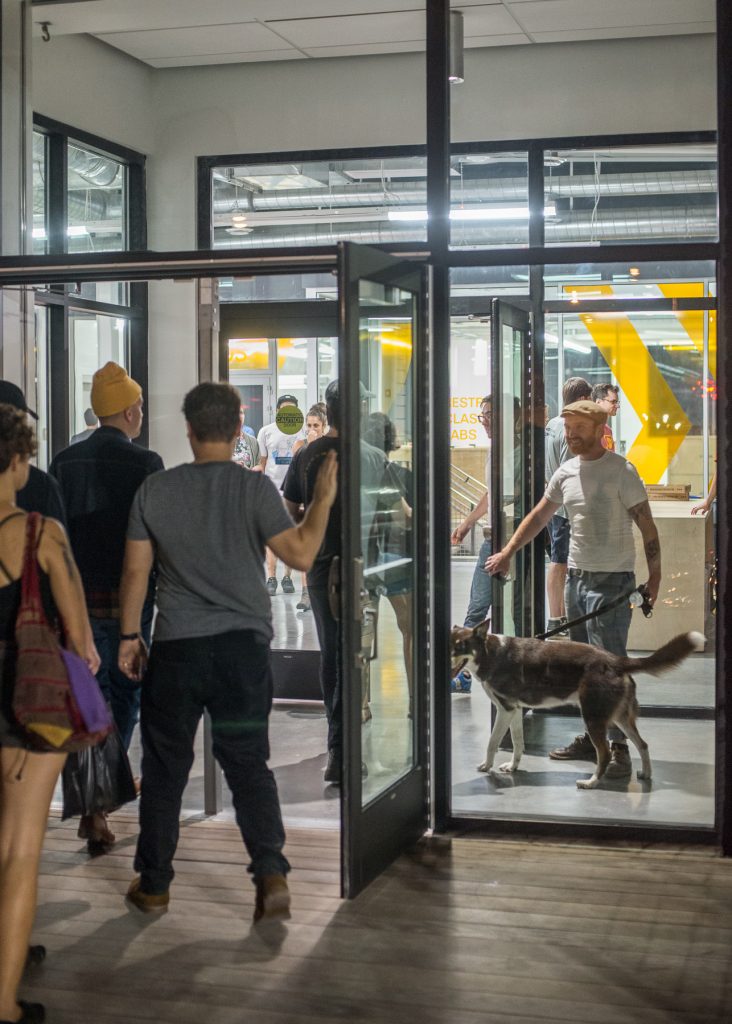
*****
Author Cara Ober is Founding Editor at BmoreArt. Full disclosure: She also works as Communications Manager for the Robert W. Deutsch Foundation, a main funder of BARCO, owner of Open Works. All opinions and ideas expressed in this article are her own.
Photo Credit: All Photos by Tommy Bruce, shot during Alloverstreet September 2016 for the Station North Arts & Entertainment District
You are invited! A public Grand Opening Festival is happening on the Open Works campus (1400 Greenmount Ave.) on Saturday, Sept. 24 from 11:00 a.m. to 6:00 p.m.
The free community event will feature over 40 vendor booths, food trucks, live music, street art demonstrations, and group tours. The entertainment line up currently includes TT The Artist, James Nasty, Jordan August Band, and Power Wheels racing— the only sub-$500 electric vehicle racing series that features adults driving kid’s cars.
For more information visit www.openworksbmore.com.






